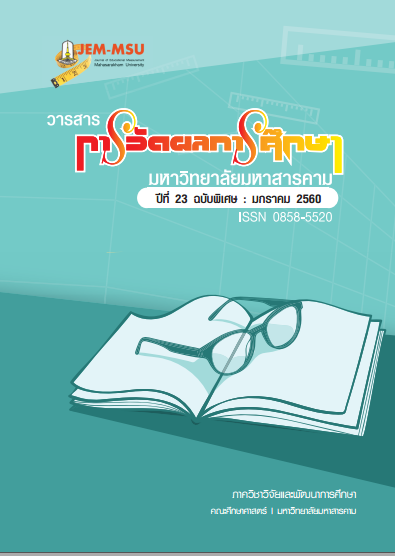The relationship between management factors and the effectiveness of school’s academic affairs in the office of Mahasarakham Primary Educational Sevice Area Zone 2
Main Article Content
Abstract
The purposes of this research, the relationship between management factors and
the effectiveness of school’s academic affairs in the Office of Mahasaraskham Primary
Educational Service Area Zone 2, were as following:
1) to study levels of management factors which affect school’s academic affairs in
the Office of Mahasarakham Primary Educational Service Area Zone 2
2) to study levels of the effectiveness of school’s academic affairs in the Office of
Mahasarakham Primary Educational Service Area Zone 2
3) to study the relationship between management factors and the effectiveness of
school’s academic affairs in the Office of Mahasarakham Primary Educational Service Area
Zone 2
4) to build predictive equation of the operation of school’s academic affairs in the
Office of Mahasarakham Primary Educational Service Area Zone 2
The samples used in the research are 210 school directors and head of academic
teachers which 105 of them were school directors and another 105 of them were head of
academic teachers in school’s academic affairs section of the schools in the Office of
Mahasarakham Primary Educational Service Area Zone 2. The instruments used in this
research were interview and questionnaire which the reliability value was 0.89 and the
discrimination was between .38 - .81. The data was analyzed by SPSS to find percentage,
means, standard deviation (S.D.) while the hypotheses were tested by Pearson’s Product
Moment Correlation Coefficient and Multiple Regression Analysis. The results showed that:
1) The overall levels of management factors affecting the effectiveness of school’s
academic affairs in the Office of Mahasarakham Primary Educational Service Area Zone 2
were high. Considering each factor in descending order showed that the highest average
which was 4.11 was teacher factors, environmental factors at 4.06, school director factors at
4.04 and budget factors at3.68 which was the lowest.
2) The overall levels of the effectiveness of school’s academic affairs in the Office of
Mahasarakham Primary Educational Service Area Zone 2 were high. Considering each factor
in descending order showed that the highest were assessment and credit awarded at 4.11,
teaching and learning management at 4.04, school curriculum development at 3.97 and the
lowest are supervision, materials development and using technology in education at 3.63.
3) the relationship between management factors and the effectiveness of school’s
academic affairs in the Office of Mahasarakham Primary Educational Service Area Zone 2 was
found that The correlation coefficient between each predictor and criterion variable were
between .531 - .761 and revealed that it had the positive relationship at the .05 level of
significance. The predictor that had the highest relationship was management factors (X5)
with the correlation coefficient of .761, budget factors (X4) with the correlation coefficient of
.725, environmental factors (X3) with the correlation coefficient of .674 and the lowest
relationship was teacher factors (X2) the correlation coefficient of .531 in descending order.
4) Predictive equation of the effectiveness of school’s academic affairs in the Office
of Mahasarakham Primary Educational Service Area Zone 2 found that each effective
predictor obtained the relationship in the following orders: management factors (X5), budget
factors (X4), environmental factors (X3), teacher factors (X2). The predictive coefficients value
was .854. Coefficient of adjustment was .697. The correlation coefficient of predict was .702.
Standard deviation was .334. The validity was 70.2 percent. The findings could be applied in
forms of raw scores and standardized scores in predictive equations as follows:
Equation of raw score:
= .693 + .359X5 + .215X4 + .154X3 + .107X2
Equation of standard score:
= .471Z5 + .242Z4 + .136Z3 + .151Z2
Article Details
The content and information contained in the published article in the Journal of Educational Measurement Mahasarakham University represent the opinions and responsibilities of the authors directly. The editorial board of the journal is not necessarily in agreement with or responsible for any of the content.
The articles, data, content, images, etc. that have been published in the Journal of Educational Measurement Mahasarakham University are copyrighted by the journal. If any individual or organization wishes to reproduce or perform any actions involving the entirety or any part of the content, they must obtain written permission from the Journal of Educational Measurement Mahasarakham University.


